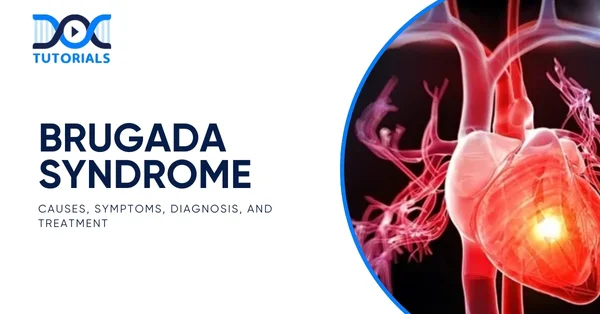Brugada Syndrome: Causes, Symptoms, Diagnosis, and Treatment

Brugada syndrome is another rare heart disorder that distorts the functioning of the heart through the electrical activity and may result in abnormal heart rhythm and death due to sudden cardiac arrest. Despite low prevalence, it may happen even in people without any previous heart disease and can be detected by particular changes in the ECG.
Being a NEET PG aspirant, you must understand the causes, symptoms, diagnostic methods, and treatment options of Brugada syndrome for accurate clinical evaluation. This guide gives a complete overview of this syndrome to support your preparation and clinical reasoning skills.
What is Brugada Syndrome?
Brugada syndrome is an inherited disorder capable of causing abnormally dangerous heart rhythms. It generally makes the lower compartments of the heart (ventricles) beat fast and irregularly, so that there is inadequate blood circulation in the entire body. This can result in fainting and, in severe cases, sudden death during periods of rest or sleep.
The abrupt and unpredictable nature of this condition during sleep has also categorised the condition as sudden unexplained nocturnal death syndrome (SUNDS). It is also thought to be rare, with around 5 out of 10,000 people having this syndrome in the entire world. Though it may emerge at any age, including infancy, the symptoms tend to show during adulthood.
What are the Causes of Brugada Syndrome?
Several factors may contribute to the development or triggering of this condition:
- Genetic Mutations
This syndrome is primarily linked to mutations in specific genes that regulate the movement of ions in and out of heart cells. These mutations may be passed on or can occur by themselves without a family history.
- Sodium Channel Abnormalities
Genetic mutations that lead to Brugada syndrome usually cause defects in the sodium channels within cardiac cells. This interference may disrupt the electrical activity of the heart, causing abnormal heart rhythms, and these could be life-threatening.
- Electrolyte Disturbances
Disruption of electrolytes, namely, an excess of potassium or sodium, can induce the symptoms of Brugada syndrome and augment the threat of arrhythmias.
- Medication-related Triggers
Certain drugs, including some antiarrhythmic medications and antibiotics, may bring on symptoms in individuals predisposed to Brugada syndrome.
- Substance Use
The use of substances such as alcohol or cocaine has also been identified as a potential trigger in some cases, increasing the likelihood of arrhythmias in affected individuals.
What are the Risk Factors of Brugada Syndrome?
Several risk factors are associated with Brugada syndrome:
- Sex
It is more often diagnosed in men compared to women, implying a gender-related predisposition.
- Family History
It is an inherited condition, and those who have a family history of the Brugada syndrome are at higher risk of developing this condition.
- Ethnicity
The condition appears to be more prevalent among individuals of Asian descent compared to other ethnic groups.
- Fever
Although fever is not a direct cause of Brugada syndrome, it can exacerbate the condition by disturbing the heart’s electrical activity. This may cause fainting to the extent of sudden cardiac arrest, especially in children with the disorder.
What are the Symptoms of Brugada Syndrome?
The severity and type of Brugada syndrome symptoms vary depending on the nature of the arrhythmia involved:
- Arrhythmia
An irregular heartbeat may occur, with the heart beating too quickly. This can create sensations of fluttering, pounding, or skipped beats in the chest. Individuals may also experience breathlessness, chest pain, or dizziness.
- Palpitations
Episodes of atrial fibrillation can lead to rapid, irregular activity in the upper chambers of the heart. This can feel like a racing, doubling, or flip-flopping heartbeat.
- Syncope (fainting)
Fainting can happen suddenly due to excessively fast rhythms in the lower heart chambers. This may be accompanied by symptoms such as nausea, shortness of breath, or lightheadedness.
- Ventricular Fibrillation (VFib)
This life-threatening rhythm disorder involves erratic twitching of the lower heart chambers. Symptoms may include a racing pulse, chest pain, dizziness, difficulty breathing, nausea, and sudden loss of consciousness.
- Cardiac Arrest
In severe cases, the heart may sustain significant damage or stop altogether. This critical event may involve chest pain, weakness, breathlessness, or palpitations.
- Ventricular Tachycardia (V-tach)
Also known as polymorphic ventricular tachycardia, this condition is characterised by a rapid heart rate exceeding 100 beats per minute. When this occurs, the heart chambers cannot fill properly, which may lead to light-headedness or fainting. Prolonged episodes can become life-threatening.
- Sudden Unexpected Nocturnal Death Syndrome (SUNDS)
Around 4% to 12% of sudden cardiac deaths are linked to Brugada syndrome. One of the early signs is gasping for air during sleep, known as nocturnal agonal respiration, which often precedes SUNDS.
- Bradycardia
In some cases, the heart rate slows down significantly. This may cause confusion, tiredness, faintness, chest discomfort, or shortness of breath.
How to Diagnose Brugada Syndrome?
Several diagnostic methods are used to identify Brugada syndrome:
- Genetic Analysis
This involves examining a blood or saliva sample to detect specific gene variants linked to Brugada syndrome. If a genetic mutation associated with the condition is found, it may be advisable for close biological relatives such as parents, siblings or children to undergo screening as well.
- Electrocardiogram (ECG)
An ECG records the heart’s electrical activity and can reveal patterns suggestive of Brugada syndrome. Type 1 is considered diagnostic due to its characteristic waveform. Type 2 and type 3 patterns are less definitive and may require further evaluation. To enhance diagnostic accuracy, the ECG may be repeated multiple times with adjusted lead placements or performed before and after consuming a heavy meal.
- ECG With Pharmacological Provocation
To increase the chances of detecting the Brugada pattern, medication may be administered prior to conducting the ECG. This drug challenge test is particularly useful when the ECG shows type 2 or 3 patterns, as the medication may induce a shift to the diagnostic type 1 pattern.
Additional tests that may be used include:
- Electrophysiological (EP) Study
In cases where previous test results are inconclusive, an EP study may be performed. Thin catheters are inserted through the femoral vein and guided into the heart to monitor internal electrical activity and identify abnormal rhythms.
- Laboratory Investigations
Blood tests can be used to measure the concentration of essential electrolytes like potassium, calcium and magnesium. This assists in eliminating other possible reasons for abnormal heartbeats, which may look like or complicate the condition to be diagnosed as Brugada.
What are the Treatment Options for Brugada Syndrome?
The following are some medical and non-medical treatments for managing Brugada syndrome:
- Implantable Cardioverter-Defibrillator (ICD)
This is a surgically implanted device which is placed in the chest to record the rhythm of the heart on a constant basis. When it detects a dangerous arrhythmia, it delivers an electric shock to restore a normal heartbeat.
- Pharmacological Management
Certain antiarrhythmic medications may be used to control symptoms. However, their success can differ between individuals, and regular monitoring is often required to assess their effectiveness.
- Trigger Avoidance
Withdrawal and avoidance of known triggers, e.g., recreational drugs, too much alcohol, and certain medications (that may cause abnormal heart rhythms), are usually recommended.
- Nutritional Modifications
Cardiovascular functioning will improve when one adopts a heart-friendly diet that consists of fresh fruits, vegetables, whole grain food and lean protein.
- Physical Activity
Performing moderate exercise under medical supervision may help one improve their overall heart health, given it is suitable for the individual’s condition.
FAQs About Brugada Syndrome
- What problems can arise if Brugada syndrome is not treated?
If Brugada syndrome is not managed properly, it can cause sudden cardiac arrest, repeated episodes of fainting, and emotional or psychological stress that may affect the daily life and overall well-being of an individual.
- What are the signs of Brugada syndrome?
In most instances, Brugada syndrome presents no symptoms that can be observed. However, some individuals may experience:
- Sudden loss of consciousness or fainting
- Shortness of breath or difficulty in breathing
- Dizziness or light-headedness
- Seizures
- Palpitation
- Is Brugada syndrome an inherited heart disorder?
Brugada syndrome is an inherited heart condition that results from genetic changes affecting sodium channels in the heart. It is inherited most commonly from a single parent in an autosomal dominant fashion.
Conclusion
Brugada syndrome is a rare but potentially life-threatening inherited cardiac condition that may mimic other serious arrhythmias. Thus, it is important to understand the genetic and environmental aetiology of this condition, recognise its manifestations clinically, and be familiar with its diagnostic and treatment options. Early detection and treatment can decrease the risk of a sudden cardiac event through means such as the implantation of the ICD or through the prevention of various triggers.
As a NEET PG candidate, understanding the Brugada syndrome is crucial to making proper diagnoses during clinical practice as well as covering the exam syllabus. DocTutorials provides concise video lectures, mock tests, revision programmes and professional counselling to aid you in your preparation.
Visit our NEET PG course and take a step forward to your dream medical seat!
Latest Blogs
-

NEET PG Exam 2025- Date, Pattern, Marking Scheme, Subject Wise Weightage, and Exam Mode
NEET PG Exam 2025 is the ultimate gateway for medical graduates aspiring to pursue postgraduate courses in medicine, including MD,…
-

INI CET Exam 2025: Your Roadmap to Success – Key Topics, Strategies, and Lessons from Last Year’s Papers
The INI CET exam is more than just a test; it’s a significant milestone for many medical students aiming to…
-

INI CET Exam Success: Previous Year Question Papers & Ultimate Guide – INI CET PYQ
One can feel overwhelmed while preparing for the INI CET (Institute of National Importance Combined Entrance Test). A vast syllabus,…




